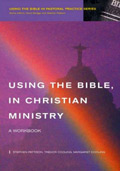 Using the Bible in Christian Ministry Stephen Pattison, Margaret Cooling, Trevor Cooling
Using the Bible in Christian Ministry Stephen Pattison, Margaret Cooling, Trevor Cooling
DLT, 2007
ISBN10: 0-232-52681-8, ISBN13: 978-0-232-52681-3) 159 pp., pb, no price marked
The Bible is a fundamental part of the Christian life. It is also a source of conflict for Christians. What is the authority of the text? How should the text be read and interpreted? In what way is the Bible a resource for pastoral practice?
This volume has emerged out of a research project between the Bible Society and Cardiff University. A number of scholars have collaborated in an investigation of how the text of the Bible is used by practitioners.
The findings of the project make for interesting reading (see www.biblesociety.org.uk) not least in the assertion that many pastors did use the Bible as a resource for practice and reflection and there was an unconscious sense of guilt linked with the lack of use of the Bible. It was this area that led to the decision to publish this present workbook on using the Bible in Christian ministry.
There are wide differences in Bible use between the traditions within Christianity and this tends to relate to people’s view of biblical inspiration and authority. These tensions and conflicts are self evident in Church life today. Can the Bible be the only authorative guide to our understanding of human sexuality or medical ethics?
This volume, therefore, engages with a complex agenda. It sets out to help practitioners reflect upon and improve their use of the Bible. The authors pay careful attention to process: activities, models, case studies and techniques are all used to enable the reader to consider what good practice is.
Does it achieve its’ aims? Consider two views. One view, rather acutely put, to stimulate thought! In the process of offering clarity or intellectual complexity and integrity is lost. What this book offers is fragments; one bit of stimulus after the other but do the anthems allow the text to challenge the reader?
In the process of the reflection, the reader remains the same busy, worthy person they were at the start, but with the mind full of process and activities that try to tell you how to handle life. At no point does the book consider what is going on in the Bible; what the mind of text it is, how its’ parts work and what the “poetry” of the text might mean? At what level does the text shape us? Is accessibility achieved at the expense of depth? What is offered here is the Bible as a rummage chest of bits that in any circumstances, we make a dip that will “help” or “fit”. The question of where this process will take us is a fundamental challenge. Will anything of any consequence happen to us amidst our activity and need to accessibility and clarity? Mark or Paul or even Jesus seem lost, taken for granted in the process: to be there in whatever we busy ourselves with, ever so worthily. The bible has got lost in its’ educational techniques.
These reflections do the volume some injustice but we need to engage in a wider debate about the Bible, its’ shape and context to enlarge our understanding of what shape theological education should take. This book is a creative resource that needs testing with individuals and groups. It is carefully organised and well written. Those responsible for training and education will find this volume useful and stimulating. It enables the reader to see how we both use and abuse the Bible.
However, the book should have been more honest about its’ limitations. Those of us involved in education need to be more critical about the relationship between the process and content of theological reflection. Is it possible to make theology accessible without sacrificing depth and learning? This book is a tool, but we need to go much further to address the challenges posed in this review.
James Woodward